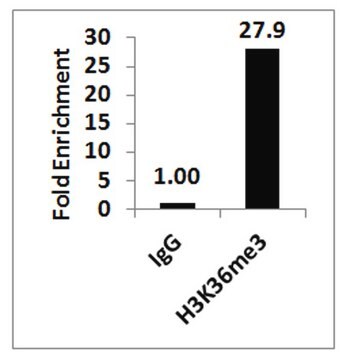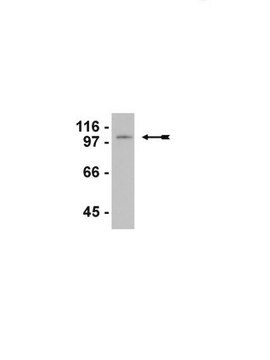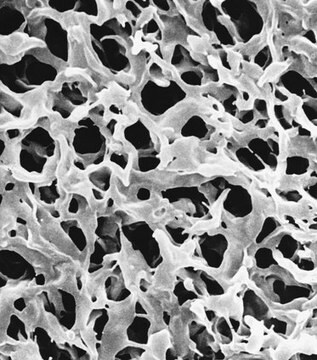17-10531
ChIPAb+ LSD1 (KDM1A) Antibody - ChIP Validated Antibody and Primer Set
from rabbit, purified by affinity chromatography
Sinônimo(s):
Lysine-specific histone demethylase 1A, BRAF35-HDAC complex protein BHC110, Flavin-containing amine oxidase domain-containing protein 2
About This Item
Produtos recomendados
fonte biológica
rabbit
Nível de qualidade
clone
polyclonal
purificado por
affinity chromatography
reatividade de espécies
rat, human, mouse
fabricante/nome comercial
ChIPAb+
Upstate®
técnica(s)
ChIP: suitable
immunoprecipitation (IP): suitable
western blot: suitable
nº de adesão NCBI
nº de adesão UniProt
Condições de expedição
dry ice
Descrição geral
The ChIPAb+ LSD1 (KDM1A) set includes a LSD1 antibody, a Normal rabbit IgG and positive control primers which amplify a 85bp human prostate-specific antigen enhancer region. The LSD1 antibody and negative control IgG are supplied in a scalable "per ChIP" reaction size and can be used to functionally validate the precipitation of LSD1 associated chromatin.
Imunogênio
Aplicação
Sonicated chromatin prepared from hormone starved (72 hrs), then androgen agonist induced (1 µM CI-4AS-1 overnight) LNCaP cells (~1e5 cell equivalents per IP) were subjected to chromatin immunoprecipitation using 2 µg of either Normal Rabbit IgG (Part No. PP64B), or 2 µg Anti-LSD1 (Part No.CS207350) and the Magna ChIP HiSens (Cat. # 17-10460). Successful immunoprecipitation of LSD1 associated DNA fragments was verified by qPCR using ChIP Primers, PSA (Part No. CS207340) as a positive locus, and ChIP Primers, β-globin (Part No. CS200591) as a negative locus.
Please refer to the Magna ChIP HiSens (Cat. # 17-10460) or EZ-Magna ChIP HiSens(Cat. # 17-10461) protocol for experimental details.
Chromatin Immunoprecipitation:
Sonicated chromatin prepared from hormone starved (72 hrs), then androgen agonist induced (1 µM CI-4AS-1 overnight) LNCaP cells (1e5 and 1e6 cell equivalents per IP) were subjected to chromatin immunoprecipitation using 2 µg of either Normal Rabbit IgG (Part No. PP64B), or 2 µg Anti-LSD1 (Part No. CS207350) and the Magna ChIP HiSens Kit (Cat. # 17-10460). Successful immunoprecipitation of LSD1 associated DNA fragments was verified by qPCR using ChIP Primers, PSA (Part No. CS207340).
Please refer to the Magna ChIP HiSens (Cat. # 17-10460) or EZ-MagnaChIP HiSens (Cat. # 17-10461) protocol for experimental details
Western Blotting Analysis:
HeLa nuclear extract was probed with Anti-LSD1 (0.05 μg/mL).
Proteins were visualized using a Donkey Anti-Rabbit IgG secondary antibody conjugated to HRP and a chemiluminescence detection system.
Epigenetics & Nuclear Function
Histones
Embalagem
Qualidade
Please refer to the MagnaChIP HiSens (Cat. # 17-10460) or EZ-MagnaChIP HiSens (Cat. # 17-10461) protocol for experimental details.
Descrição-alvo
forma física
Normal rabbit IgG, Part No. PP64B. One vial containing 125 µg Rabbit IgG in 125 µL storage buffer containing 0.05% sodium azide. Store at -20°C.
ChIP Primers, PSA. Part No. CS207340. One vial containing 75 μL of 5 μM of each primer specific for human prostate-specific antigen (PSA) enhancer region (chr19:51354179-51354263, hg19 build). Store at -20°C.
FOR: GCC TGG ATC TGA GAG AGA TAT CAT C
REV: ACA CCT TTT TTT TTC TGG ATT GTT G
Armazenamento e estabilidade
Nota de análise
Includes normal rabbit IgG and primers specific for a human prostate-specific antigen (PSA) enhancer region.
Outras notas
Informações legais
Exoneração de responsabilidade
Código de classe de armazenamento
10 - Combustible liquids
Certificados de análise (COA)
Busque Certificados de análise (COA) digitando o Número do Lote do produto. Os números de lote e remessa podem ser encontrados no rótulo de um produto após a palavra “Lot” ou “Batch”.
Já possui este produto?
Encontre a documentação dos produtos que você adquiriu recentemente na biblioteca de documentos.
Nossa equipe de cientistas tem experiência em todas as áreas de pesquisa, incluindo Life Sciences, ciência de materiais, síntese química, cromatografia, química analítica e muitas outras.
Entre em contato com a assistência técnica







